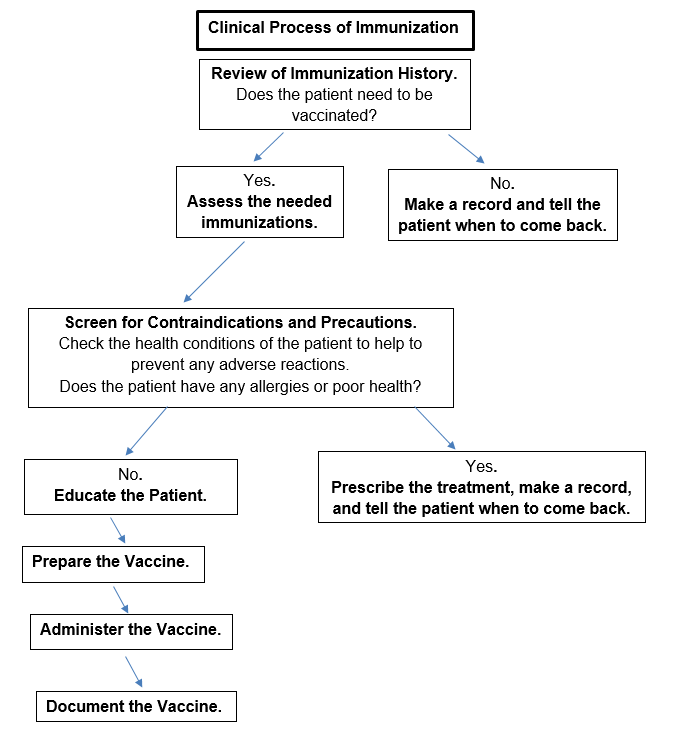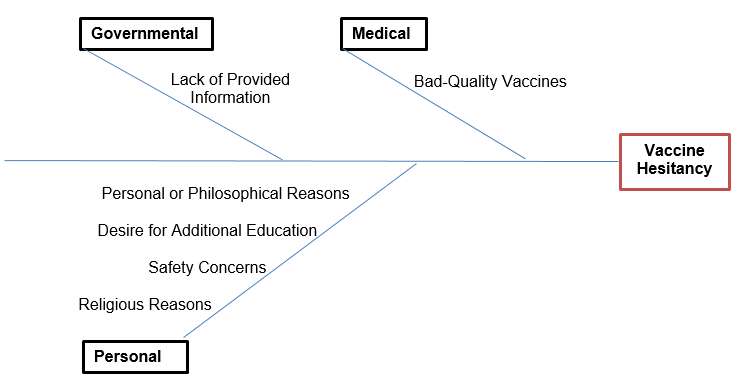Contracting a disease, especially a severe one, and not being able to afford the necessary treatment is considered to be one of the most acute fears of a great number of people. Governments and healthcare providers have acknowledged the danger of contagious diseases and launched a mandatory immunization program, which is making people immune to infections by inoculation. Despite some rather obvious benefits of vaccinations, some people refuse them and stand for their right to be unimmunized. The purpose of this paper is to make an RCA, root cause analysis, of the problem of people refusing immunization and vaccination. The analysis will include a diagram of the clinical process of immunization and a fishbone diagram of constraints. Finally, the steps for improvement, utilizing the five-whys tool, and ways for making those changes will be suggested.
Immunization
The fact that parents refuse immunization, and the incidence of vaccine-preventable diseases among children increases makes the public concern grow. There are many studies that examine the reasons why parents postpone, refuse, or are “hesitant to vaccinate their children” (McKee & Bohannon, 2016, p. 104). These reasons are rather different but can be divided into four major categories: philosophical considerations or personal beliefs, religious ideas, safety concerns, and the desire to receive more information from health professionals. All of these concerns about immunization lead to parents decide to refuse all vaccines or only certain ones.
In addition, there are those parents who only delay making some of them so that they become more spread out. However, immunization is rather crucial as it helps to protect people from getting an infectious disease. Moreover, when a person gets vaccinated, he or she helps to protect others as well. Immunization is an entirely safe process, and it is much safer to get the vaccine than an infectious disease.
Diagram of the Clinical Process of Immunization

Fishbone Diagram of Constraints

Steps for Improvement Using the Five-Whys Method
In order to understand how to solve the problem of people refusing immunization and vaccination, it is essential to find the root reason for their decision. This will be done with the help of the five-whys method (“Determine the root cause”). To use this method correctly, first, it is necessary to define the problem statement, and then start asking questions until the answer to one of them may be considered as the root cause of the issue.
Problem statement: even though immunization is proved to be helpful, people continue refusing to be vaccinated.
- Why do people refuse to be immunized? – It happens because some of them do not trust this process.
- Why do some people not trust this process? – There are theories that immunization is dangerous and influences the health system of a person in a wrong way, and people believe in them (“Common vaccine safety questions,” 2016).
- Why do people believe in them? – People believe in the theories about immunization being dangerous because of the lack of information that the government and the healthcare provide the citizens with.
Hence, this is the root cause of the issue that is being analyzed in this paper. The steps that may be made after finding the root problem are rather simple. First, it is essential to tell the parents about those studies that consider immunization to be a safe and necessary process. Then, some statistics about immunized and unimmunized children may be demonstrated so that those parents who refuse vaccination face the risks and decide whether they want to take them. Finally, the government may organize some free lectures where professionals would explain the necessity and importance of immunization, answer the questions that worry people, and softly convince them to change their minds and agree for vaccinations.
Suggested Changes for Making the Improvements
There is a large number of parents who admit that they have questions and concerns about childhood immunization. This is why it would be rather helpful for pharmacists and medics to keep in mind and understand all people’s reasons for refusing vaccination. In this case, all healthcare providers are more prepared to help their patients. Providing all the necessary information, educating parents, and explaining to them that this process is safe and essential for children play a key role in convincing parents in agreeing for immunization.
They should stop worrying and being afraid that vaccination is dangerous and understand that being unimmunized is much more dangerous and puts their children’s health at risk. Moreover, probably the way the government tries to solve this problem should be changed. There is no need to make parents vaccinate their children; instead, it is good to let them choose and convince them that the best and safest choice is immunization.
References
Common vaccine safety questions and concerns. (2016). Web.
Determine the root cause: 5 whys. Web.
McKee, C., & Bohannon, K. (2016). Exploring the reasons behind parental refusal of vaccines. The journal of pediatric pharmacology and therapeutics, 21(2), 104–109.